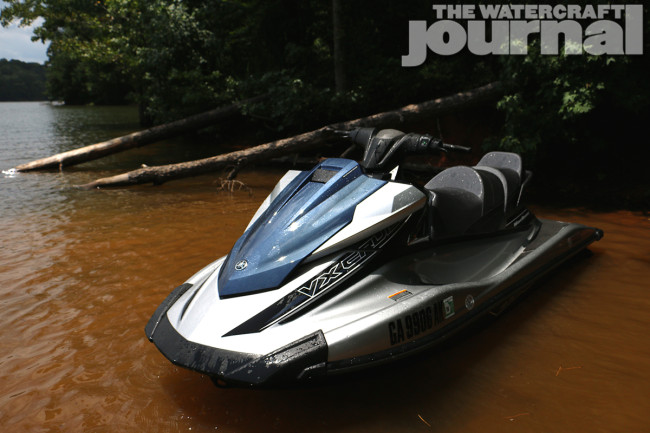We spend a lot of time on a couple of lakes around our Nashville, Tennessee office. More often than not, we reserve our testing days for during the middle of the week just to avoid other boat traffic and fishermen. Yet, on the rare weekend where we find ourselves enjoying some riding time, we try to pay close attention to what brands and models of other craft we encounter (actually, we do this almost always, but it’s worth noting).
And what we find more often than not is the majority of personal watercraft enthusiasts directly reflect the reported sales averages coming in from dealers across the globe: males averaging 46-to-50 years old, riding a naturally-aspirated three-seater runabout. Sure, while the supercharged 300-horsepower fire-breathing machines are sexy as can be, it’s the craft touting the most fuel consumption, stability and comfort for the best bargain that sees the most seat time.
This fact is more or less Yamaha’s modus operandi, and is evident in its efforts to continually improve their ever-popular VX Series of watercraft. While the current VX models ride on a new, dramatically redesigned hull (first introduced for the 2015 model year), the vehicle segment boasts the industry’s longest-running “best selling” model in the industry. For 2016, Yamaha has only improved on an already impressive machine, and looks to strike at the aforementioned core demographic with laser focus.
In getting our hands on the 2016 Yamaha VX Cruiser WaveRunner long before anyone else, we wanted to rack up some serious time on the budget-billed family cruiser. While the exterior of the VX remains the same – save for some gorgeous Silver Metallic with Slate Blue Metallic coloring (all international VX Cruisers are available in white) – the heart of the new Cruiser is entirely new.
Sharing the same all-new TR-1 1,049cc (1-liter) 3-cylinder 4-stroke powerplant, the TR-1 replaces the outgoing MR-1 4-cylinder. Not only is the new dual-overhead cammed 3-cylinder provide 13-percent more horsepower (an official 125 horsepower) than the old engine, it also shaves off 20-percent of the outgoing engine’s heft, and an impressive 40-percent of its overall size. So not only is the TR-1 more powerful but lighter, dramatically improving the VX Cruiser’s power-to-weight ratio. This gives the runabout a more nimble feel and noticeably sharper throttle response.
Of course, the TR-1 benefits from the use of Yamaha’s NanoXcel durable-as-it-is-lightweight hull material, giving the VX Cruiser crisp acceleration and a strong latitudinal torque curve. Its 668-pound dry weight allows the runabout to rise to plane quickly and continue to pull up to a GPS recorded 55.3mph. As the Cruiser shares the same hull as the National Championship-winning VXR and VXS, it also is apt at carving and twisting through the S-turns when so inclined.
Truly, the VX Cruiser is playful when directed as such, and can happily whip the tail out in terrific roost during horseplay. But, when under more docile control, the VX Cruiser spiritedly sluices through boat wakes, its thick, bolstered and tiered Cruiser seat absorbing small chop. Equally, the VX Cruiser is adequately powered to tow the kids on an inflatable or a single wakeboarder without bogging down.
Equipped with Yamaha’s dual-throttle braking system (RiDE), the VX Cruiser comes to a controlled stop without plowing the nose underwater, or the pump rising out of the water and disengaging. Yamaha has smartly arranged the VX Cruiser’s toggles within thumb’s reach – be it toggling through its Cruise Assist settings or engaging the No Wake mode. Ergonomic “pistol-style” handgrips are contoured but not overbearing, and the fly-by-wire throttle triggers retain a realistic feeling of a cable when there isn’t one.
The VX Cruiser’s steering system is fixed (no tilt adjustment) which is the same across the board for all VX Series machines, so the very upright position might irk either significantly shorter or taller riders, as might the “assigned seating” positions of the Cruiser seat. But then again, that it entirely up to personal preference.
The Cruiser does tout some serious storage throughout the runabout – a total 24.6 gallons spread between bow storage, a moderately-sized glove box (with two cup holders), and a screw-top watertight bin beneath the rear bench. The front hood hinge is not spring loaded, but can be locked in place by extending it all the way up until you hear an audible “click.” Until we learned this we had a couple of run-ins with a falling hood.
The LCD digital dash is simple and easy to navigate even as speed, and graciously resistant to glaring. Of course, the VX Cruiser comes with Yamaha’s Security Mode remote transmitter that locks the WaveRunner’s ignition when activated. Other goodies include a two-tone black-and-gray Hydro-Turf mat kit covering the gunwales and wide rear boarding platform. A broad folding swim step makes reboarding a cinch.
Priced at $10,499, we wish a few of bonus features of the equipped-to-the-gills VX Limited were shared (particularly the 12-volt charging port in the glovebox) with the Cruiser, especially as the Limited is only $400 extra. Nevertheless, the 2016 Yamaha VX Cruiser WaveRunner‘s new TR-1 fuel-efficient plant meagerly sips from its 18.5-gallon tank, and Yamaha’s record for quality control promises endless days of uninterrupted riding for the whole family.

















































Hmmm… I have been looking at a couple of models with the 1.8L engine (VXR @VX Cruiser HO), but may have to reconsider one with the new engine. Kevin, maybe you can comment on if there is a big disparity between the two engines as far as the power. Is the feeling of power adequate enough or would regret eventually set in for not choosing something with more power?
Obviously, the larger HO 1.8L touts 60 horsepower over the 1L TR-1, and given the larger displacement the HO’s torque curve is noticeably taller. It all depends on what you’re looking for. We applaud the 1L TR-1 for its 125HP and linear torque curve particularly for an entry-level engine (particularly when compared to the outgoing engine). If you’re looking for performance, go with the HO or SVHO. If you’re looking for a solid entry level/family runabout, the TR-1-equipped VX models are an excellent choice.
It will be used mainly for riding with the kids and pulling inflatables. I will be doing some solo rigding also. I guess it will come down to do I want better performance or better fuel economy. It looks like the 1.8L naturally aspirated engines aren’t to bad as far as fuel economy goes but I’m sure the TR-1 is much, much better. Anyway, I really enjoy your site. It’s become my go to sight for PWC info and news. Keep up the good work!
[…] The fixed handle, but this may only be a problem for taller or shorter riders to steer. (source). […]